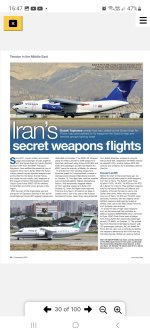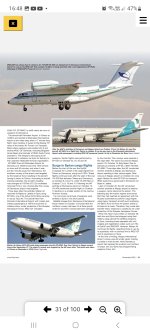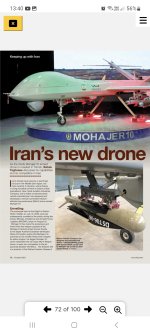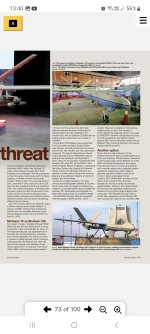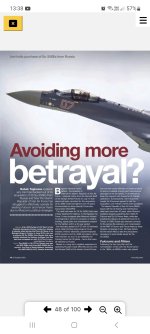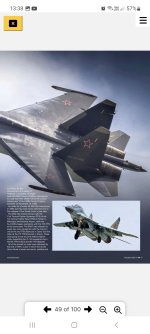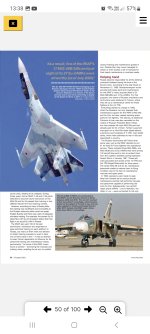IRAN’S UNMANNED AMBITION
- Aviation Features
- Iran’s unmanned ambition
14th July 2021
FEATURE
Shorn of the ability to access key international markets, Iran has had to focus on developing indigenous industries to provide its armed forces with the capabilities required, including unmanned aerial vehicles, which could be cause for concern for Western powers with interests in the region. Richard Thomas reports
The Mohajer-6 is one of the most recognised platforms in Iran’s UAV inventory
Ali Naderi
Cut off from most of the world’s defence and security markets, and hit by US and Western sanctions for decades, Iran has often had to rely on its own indigenous industry to develop military capabilities that countries might otherwise take for granted. In the unmanned sector, Tehran has had success in the internal development of a range of UAVs (unmanned aerial vehicles) to serve the needs of its military, and potentially looked to exploit and harness the research and design progress of its rivals through more direct means.
One such instance occurred in 2011, when Iran claimed to have captured a US-operated RQ-170 UAV that was operating in its airspace – an act later confirmed by the United States government. Although the exact method with which Iran was able to acquire the platform has not been publicly released, it represented a coup for Iran and one that would offer up no shortage of unmanned insight to the regime, through a process of reverse engineering.
Indeed, coverage by Iranian media in 2016 of the new Saegheh UAV suggested a possible design influence from the RQ-170, according to a Reuters report at the time.
This would not be an isolated incident. In mid-2019, Iran intercepted an RQ-4A Global Hawk UAV, which typically operates as a high-altitude surveillance and information gathering platform. Again, Iranian claims stated that the shootdown was justified, as the platform was operating inside its airspace. However, this was denied by the US Department of Defense (DoD).
Iran displayed wreckage of what it claimed was the downed RQ-4A through state media channels. While it would not have had the same opportunity to reverse-engineer to the degree that it managed to do with the RQ-170, materials research and other insight would have been gleaned and fed back into Iran’s own domestic programmes.
Turning to domestic development, there have been suggestions that Iran’s unmanned capabilities continue to progress. In a June 27 statement, Islamic Revolution Guards Corps (IRGC) commander Maj Gen Hossein Salaami said that the country’s armed forces operate RPAs (remotely piloted aircraft) with a 4,350 mile (7,000km) range. But verification of these claims is difficult.
Bearing a resemblance to platforms developed previously by western countries, the Shahed-129 has munitions hardpoints and an EO/IR capability
Ali Naderi
The Kian loitering munition (left) and target drone (right) are a pair of more recently developed systems
Keyvan Hosseini
“They can fly and make landing wherever they are planned to," Salaami said, according to the IRNA state news agency.
The platforms
Concise and in-depth information on Iran’s domestically produced platforms is not always available. However, documentation from Western militaries, think tanks and other publicly available sources paints a picture of intent to use unmanned systems as a force multiplier for regional influence and future conflict.
As witnessed in the recent Nagorno-Karabakh conflict between Armenia and Azerbaijan – which was a clear indication as to how conventional warfare is changing – unmanned systems should no longer be considered a ‘nice-to-have’ but an essential military capability. Iran’s current crop of UAVs, many the latest in a familial series, cover a cross section of typical roles undertaken by such systems. According to a country analysis of Iran’s UAVs, the UK Royal United Services Institute think tank pointed to two platforms – the Shahed-129 and Mohajer-6 – as being able to carry out strike operations, rather than just unarmed intelligence, surveillance and reconnaissance (ISR) activities.
The medium altitude, long endurance (MALE) Mohajer-6, manufactured by Qods Aeronautics Industries (QAI), is thought to have a 93 mile (150km) range and features an electro-optical infra-red (EO/IR) payload and laser designator to assist targeting for the missile carried on two hard-points, one on each wing. It is the latest in the line of Mohajer UAVs produced by QAI – the first iteration dates back to the mid-1980s.
The MALE Shahed-129, manufactured by Shahed Aviation Industries, is also thought to have a range of about 93m (150km), featuring a similar fit-out to the Mohajer-6, with an EO/IR gimbal and laser designator for up to four missiles carried on hardpoints under the wings.
The Sadegh-1 UCAV (unmanned combat aerial vehicle), which was unveiled in 2014, appears similar to the Mohajer-6 and could be another system designed and developed by QAI.
Meanwhile, the Ababil-3 is one of Iran’s newest UAVs to enter service. Unveiled in April 2020, it is the latest evolution of the Ababil family of systems manufactured by the Iran Aircraft Manufacturing Industrial Company, and a significant redesign from the earlier Ababil-2.
Data compiled by the US Center for New American Security indicates a platform endurance of about four hours and 62 miles (100km) range, while images published at the time of unveiling indicate the Ababil-3 can carry air-to-surface missiles on two hardpoints, unlike its predecessor. The Ababil-3 also contains an EO/IR payload, providing a real-time surveillance capability.
The Shahed-191 – which bears a clear resemblance to the US-manufactured RQ-170 – was unveiled in 2016 and appears to be primarily an ISR platform, although Iranian media coverage has indicated a kinetic munition payload capability. Given the difficultly involved when it comes to determining the platform’s characteristics, this is unable to be verified independently.
The Sayeh-2 platform and older Sayeh-1 is predominantly used for maritime surveillance
Ali Naderi
Iranian UAVs often feature an extensive familial back catalogue, such as the Mohajer-4
Keyvan Hosseini
In 2018 Israel shot down a Shahed-191, purportedly operating from Syria, after it had crossed into Israeli airspace.
In perhaps another example of Tehran’s reverse engineering or platform copying ability, the Sayeh-2 UAV appears to be based on the ScanEagle platform, which was commonly operated by US Navy vessels in the Middle East region. In 2019, in a widely reported incident, Iran claimed a UAV, possibly a Sayeh design, operated by the IRGC overflew a US Navy aircraft carrier in the Arabian Sea.
Tehran has also developed a jetpropelled family of loitering and target UAVs, dubbed Kian, which was unveiled in a ceremony in 2019 in the presence of Brig Gen Alireza Sabahifard, commander of the Iranian Army Air Defense Force. According to IRNA, Sabahifard said during the event that the Kian was able to conduct reconnaissance and surveillance missions and had been developed in two versions – although available images point to target and strike roles, due to the apparent absence of an EO/IR payload.
Possible proliferation
The United States – one of Iran’s principal rivals since its Islamic Revolution overthrew the incumbent political force of the Pahlavi monarchy – has long-been concerned by Iranian influence in the Gulf and wider Middle East region. For decades, the two countries have sought to contain the influence of the other, resulting with a number of incidents that, while falling below the threshold of war, served to ratchet up regional tensions.
One of the main concerns for the US and its allies is the proliferation of Iranian technology through the region, for use by its own forces or other movements that are aligned, either loosely or more tightly, with Tehran’s ambitions.
Charting developments over the past four years, there have been repeated efforts by the US government to highlight the proliferation of Iranian technology in the region to its many proxy forces or allies, such as the Houthi in Yemen, Hamas in the Gaza Strip or Hezbollah in Lebanon and Syria. US-based think tanks have also written extensively on the topic, warning of the threats posed by Iranian UAVs.
In December 2017, the US Department of Defense News published an article claiming what it said was proof of Iran’s influence in the Middle East and the proliferation of its military hardware through the region. During a presentation at Joint Base Anacostia-Bolling, located near Washington, DC, DoD officials presented a series of systems that were said to have originated from a variety of battlefields in the Middle East.
Among the systems on show – which included a short-range ballistic missile and anti-tank munitions – was a Qasef- 1 UAV that officials said included parts manufactured by and originating from the Iranian defence industry. Operated by Houthi forces in Yemen, the Qasef- 1 loitering munition has been used to significant effect in strikes both in-country and in Saudi Arabia.
At the time, United States officials said that Iran manufactures the Qasef-1, which was a member of the Ababil UAV family designed and produced by the Iranian government.
Meanwhile, in a 2019 Heritage Foundation report into the growing threat posed by Iran's UCAV fleet, senior research fellow Peter Brookes said that the systems “were a growing threat to US interests in the region”, particularly deployed US military forces.
The Sadegh-1 UCAV, unveiled in 2014, appears similar in aspect to the Mohajer-6
Ali Naderi






